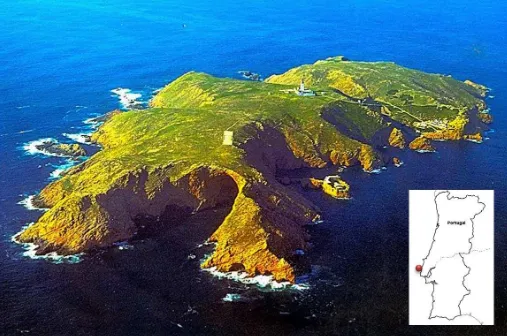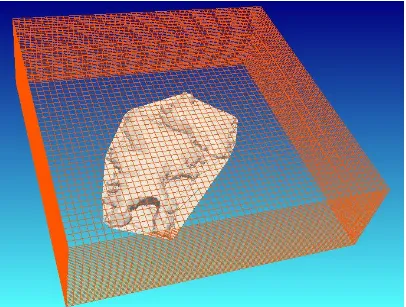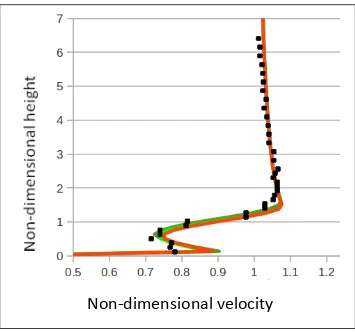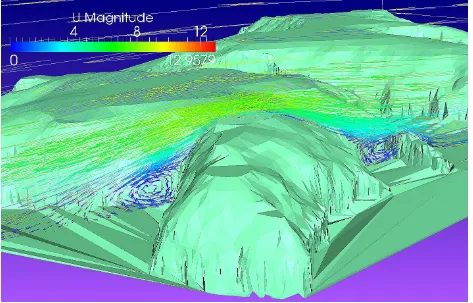1
An Open Source CFD Study of Air Flow over Complex Terrain
S. M. Fabre1, T. J. Scanlon1, M. T. Stickland1 and A. B. Oldroyd2
1Department of Mechanical Engineering, University of Strathclyde, Glasgow, UK 2
Oldbaum Services Limited, Stirling, UK Abstract
This paper presents an open source computational fluid dynamics (CFD) study of air flow over a complex terrain. The open source C++ toolbox OpenFOAM has been used for the CFD analysis and the terrain considered is a scale model of Berlengas Island, which lies close to the Portuguese coast. In order to validate the CFD model, experimental work has been carried out in an open-section wind tunnel using hot-wire anemometry to measure the wind profiles above the island. In the majority of cases, the OpenFOAM CFD solutions show very good agreement with the experimental wind profile data, confirming that open source CFD solutions are possible for environmental flows over complex terrain.
Keywords: CFD, open source, validation, experimental, environmental, wind, complex terrain.
1. Introduction
As the deadline for the EU's promised 20% reduction in carbon emissions by 2020 fast approaches, wind energy is a key area of expansion for EU member states in order to meet their renewable energy obligations [1]. Technologies for wind flow analysis are required to facilitate better project planning, accurate yield prediction, and a fundamentally better understanding of the local climate conditions. However, there remain significant challenges ahead, not the least of which is the ability of such technologies to accurately assess the wind resource potential in on-shore locations that exhibit significant variations in terrain profile and consist of complex topographies.
2
The most promising route for yield prediction in future wind renewable developments is through modelling and simulation, and the use of Computational Fluid Dynamics (CFD). The automotive and aircraft industries have already replaced the majority of their wind tunnel tests with CFD and the aero-space industry is fast following suit. While CFD has the potential to be very useful for the study of the environmental flows encountered in the wind industry — because it can deliver data that is difficult to measure or observe, under climate conditions we cannot reproduce in a laboratory — it still faces major challenges, especially if there are significant variations in the land topography.
1.1 Numerical modelling approaches for wind analysis
Several numerical simulation techniques exist for wind flow analysis, ranging in levels of complexity from simple linear solvers to direct numerical simulation. The principal analysis techniques are described below:
a) Linear models: These solve a set of linearized flow equations which contain simplified turbulence and roughness models. The models attempt to correct existing long-term physical data to account for several different effects including object blockage, terrain classification, and land topology.
b) RANS: (Reynolds Averaged Navier-Stokes): This CFD technique involves the solution of the time-averaged Navier-Stokes equations with the relevant scales of turbulence being modelled. It is the most well-known and widely-adopted method for practical engineering applications.
c) Large Eddy Simulation (LES): Another CFD approach in which the larger scales of turbulence, which contain most of the energy, are directly resolved while the smaller scales, below a certain filter level, are modelled.
d) Detached Eddy Simulations (DES): Is a mixture RANS and LES, where RANS model is employed in user-specified regions and LES in others. This hybrid modelling technique affords the user greater flexibility in the computational approach.
e) Direct Numerical simulations (DNS): This involves the direct numerical solution of the instantaneous equations that govern fluid flow (the unsteady Navier-Stokes-Fourier equations) using the appropriate length and time scales.
3
measurements for various different effects including sheltering objects, terrain classification, and domain contours. The advantage of this method is that it is well established and relatively straightforward to apply. The most widely used application of the technique is the WAsP computer code developed by the RISØ National Laboratory in Denmark. WAsP has enjoyed such widespread adoption because the use of linearized flow equations make it able to predict the wind resource with sufficient accuracy and efficiency when the terrain is smooth enough to ensure that the flow remains attached. However, WAsP does have limitations and generates poor predictions when flow separation and recirculation are evident [6]. In an attempt to address this issue, a site ruggedness index (RIX) was proposed as a crude measure of the terrain complexity and hence the extent of flow separation [7]. The RIX is defined as “the fractional extent of the surrounding terrain which is steeper than a certain critical slope”. However, despite corrections using the RIX, many researchers have concluded that it is not generally advisable to apply WAsP in complex terrain [7-10]. These conclusions, combined with the observation that the increase in wind power production has led to sites being selected with increasingly complex terrain [8], mean that alternative computational methods need to be established.
The choice of computational model requires the user to strike a delicate balance between required accuracy and the computational resources available. The range of length and timescales involved in DNS means that significant computational resources are required and the technique is currently impractical for real-world engineering problems. Employed correctly, LES-based modelling is likely to predict results with a higher degree of accuracy compared with RANS models, however, for the large, 3D, complex geometry problems normally encountered in the wind industry, the computational resources for a LES-based solution are currently beyond the reach of the general wind-energy community. Therefore, the current basis for the modelling and simulation of environmental flows in complex terrain is dominated by the use of linear and RANS-type models.
Given the limitations in the range of topologies that linearized models can handle, CFD is the evident choice as an alternative to WAsP and other linearized approaches, with the RANS approach the most likely choice given the computational restrictions. However, despite the impact of CFD techniques in many areas, such as automotive or aeronautical engineering, it has not yet become common in wind energy engineering [8]. Challenges remain in the numerical modelling of turbulence for atmospheric flows, particularly in complex terrain, and in CFD representations of atmospheric boundary layers [11, 12].
1.2 Open source CFD for complex terrain
4
flexibility in the development of additional modules and the unlimited parallel processing capacity means that practical engineering problems may be tackled within realistic time scales and on modest hardware budgets.
OpenFOAM has been applied previously to atmospheric flows in complex terrain. Risø DTU, the National Laboratory for Sustainable Energy of Denmark, recently organized a blind comparison of flow models for the evaluation of wind over complex terrain [14] based on a new dataset of measurements collected on the isolated presqu'ile of Bolund [15]. One of the main objectives of this exercise was to assess the competency of current wind resource assessment techniques in complex terrain. This flow case met the requirement of “complex” as, for primary wind directions, the orography resembles a forward-facing step and, with respect to the shallow boundary layer developed over open water, the step height was relatively large. Participation was open to all and, although the boundary conditions were tightly specified for consistency, modelers were free to select their simulation technique of choice to calculate the flow field. The two OpenFOAM simulations submitted [16] were ranked first and fifth with overall mean errors in predicted velocity of 13% and 14%. These results highlighted the capabilities of open source CFD and helped establish OpenFOAM as a credible alternative to commercial CFD packages in the wind energy industry. Tapia [17] has used OpenFOAM to develop roughness models and applied the code to flow situations over terrain of a limited degree of complexity. Comparisons of velocity profiles with those predicted by the industrial CFD code Fluent showed an excellent level of agreement and served to validate the open source code against one of its commercial equivalents.
5
Figure 1 Berlengas Island with insert showing approximate geographic location 2. Experimental work
3. Numerical analysis
6
Figure 2 CAD model of Berlengas island in .stl format
[image:6.595.100.506.377.684.2]7
Figure 4 Snapped surface mesh on the island
8
[image:8.595.121.476.63.395.2]Non-dimensional velocity
Figure 5 Mesh sensitivity analysis for the 210o flow angle case. Lines – OpenFOAM; symbols – wind tunnel.
dark green – 0.7 million cells; light green - 1.2 million cells; red – 2 milllion cells 4. Results
9
[image:9.595.76.531.61.706.2]
Figure 6 Velocity profiles for flow angles 0o to 150o. Lines - OpenFOAM, symbols – wind tunnel.
Non-dimensional velocity : 30
oNon-dimensional velocity : 0
oNon-dimensional velocity : 60
oNon-dimensional velocity : 90
o10
[image:10.595.46.517.53.739.2]
Figure 7 Velocity profiles for flow angles 180o to 330o. Lines - OpenFOAM, symbols – wind tunnel.
Non-dimensional velocity : 180
oNon-dimensional velocity : 210
oNon-dimensional velocity : 240
oNon-dimensional velocity : 270
o11
Figure 8 Velocity vectors showing flow separation and recirculation in the island canyons 5. Conclusions
The open source CFD code OpenFOAM has been used in a study of air flow over a complex terrain. Comparisons of OpenFOAM and wind tunnel studies show very good agreement for wind speed measurements above the island and flow separation and recirculation features in island canyons have been captured successfully. These results confirm that open source CFD solutions on a modest hardware budget are feasible for environmental flows over complex terrain. Finally, the cost benefits and open source nature of the OpenFOAM code mean that it has the potential reach a wider audience within the current wind energy analysis community.
References
1. The Accountability of European Renewable Energy and Climate Policy, CE Delft, Publication number: 11.3320.24 (2011).
2. Barthelmie R. J. et al Modelling and measurements of wakes in large wind farmsJ. Phys.: Conf. Ser
ies
, 75, (2007).12
4. Coulter, R. L. and Kallistratova, M. A., Two decades of progress in sodar techniques: a review of 11 ISARS proceedings 2003 Meteorology and Atmospheric Physics Volume 85,1-3, pp. 3-19 (2003).
5. Landberg, L., Myllerup, L., Rathmann, O., Petersen, E. L., Jørgensen, B. H., Badger, J. and Mortensen, N. G., Wind resource estimation - an overview, Wind Energy 6 (3), pp. 261–271 (2003).
6. Bowen, A. J. and Mortensen, N. G., Exploring the limits of WAsP: the wind atlas analysis and application program, European Wind Energy Conference and Exhibition, pp. 584–587. Gothenborg, Sweden (1996). 7. Mortensen, N. G., Bowen, A. J. and Antoniou, I., Improving WAsP predictions in (too) complex terrain.
European Wind Energy Conference and Exhibition, Athens, Greece (2006).
8. Palma, J. M. L. M., Castro, F. A., Ribeiro, L. F., Rodrigues, A. H. and Pinto, A. P., Linear and nonlinear models in wind resource assessment and wind turbine micro-siting in complex terrain. J. of Wind Engineering and Industrial Aerodynamics, 96 (12), pp. 2308–2326, (2008).
9. Perivolaris, Y. G., Vougiouka, A. N., Alafouzos, V. V., Mourikis, D. G., Zagorakis, V. P., Rados, K. G., Barkouta, D. S., Zervos, A. and Wang, Q., 2006 Coupling of a mesoscale atmospheric prediction system with a CFD microclimatic model for production forecasting of wind farms in complex terrain: Test case in the island of Evia. European Wind Energy Conference and Exhibition, Athens, Greece (2006).
10. Wood, N., Wind flow over complex terrain: A historical perspective and the prospect for large-eddy modelling. Boundary-Layer Meteorology, 96 (1), pp. 11–32, (2000).
11. Undheim, O., Andersson, H. and Berge, E., Non-linear, microscale modelling of the flow over Askervein Hill, Boundary-Layer Meteorology, 120 (3), 477–495, (2006).
12. Hargreaves, D. M. and Wright, N. G., On the use of the k-ε model in commercial CFD software to model the neutral atmospheric boundary layer, J. of Wind Engineering and Industrial Aerodynamics, 95 (5), 355– 369, (2007).
13. http://www.openfoam.com
14. Risø DTU: The Bolund Experiment: Blind comparison of CFD codes – Wind in complex terrain, http://www.risoe.dk/da/Research/sustainable energy/wind energy/projects/VEA Bolund/Bolund Blind Comparison.aspx?sc lang=en. (2009).
15. Bechmann, A., Berg, J., Courtney, M., Jørgensen, H., Mann, J. and Sørensen, N.: The Bolund Experiment: Overview and Background, Technical Report R-1658(EN), Risø DTU, (2009).
16. Sumner, J., Masson, C.,Odemark, Y. and Cehlin, M. OpenFOAM simulations of atmospheric flow over complex terrain, 5th OpenFOAM Workshop, Chalmers, Gothenburg, Sweden, June 21-24, (2010).
17. Tapia, X. P., Modelling of wind flow over complex terrain using OpenFoam, Master’s Thesis, University of Gävle, Sweden, June (2009).
18. http://norsewind.eu






